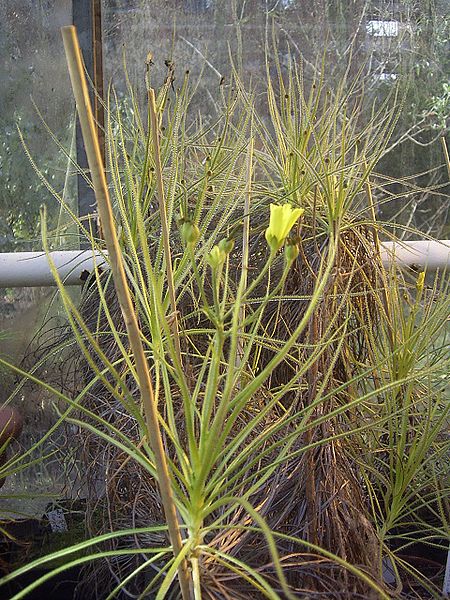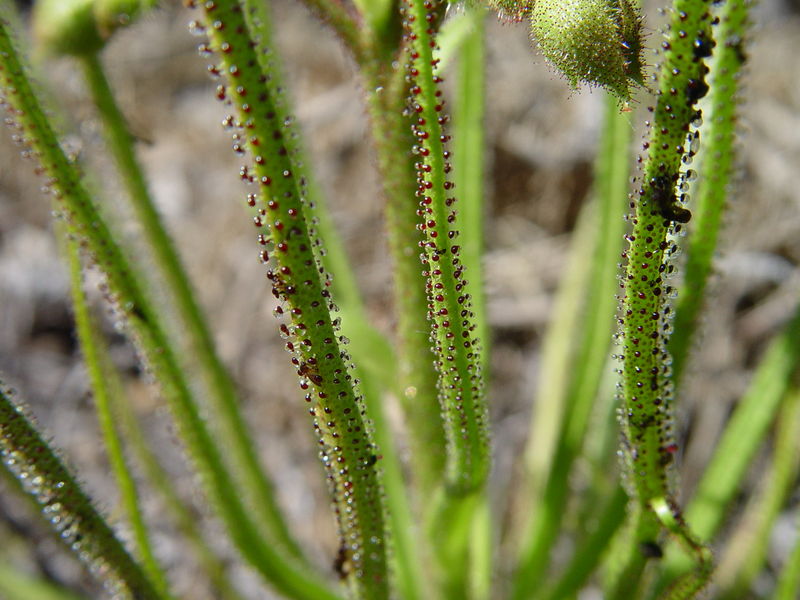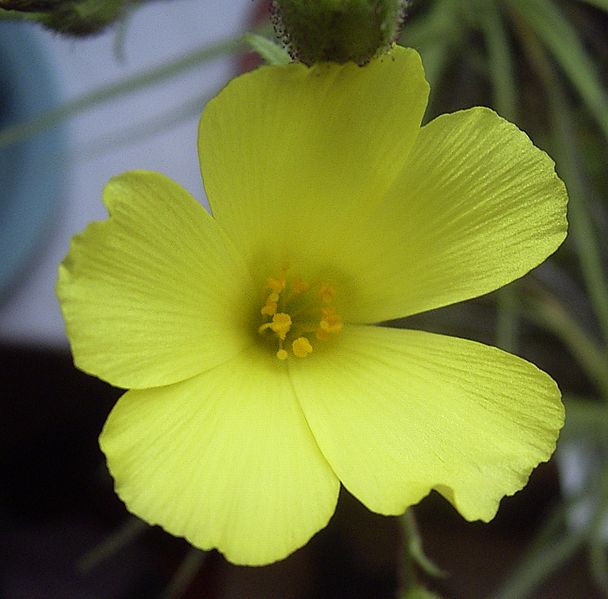Portuguese Sundew (Drosophyllum lusitanicum)

Portuguese Sundew (Drosophyllum lusitanicum) is the only species of carnivorous plant in the genus Drosophyllum of the family Drosophyllaceae, native to the western Mediterranean region in Portugal, Spain and Morocco. The genus name Drosophyllum is derived from the Greek Drosos meaning dew, and Phyllun meaning leaf or tribe. The species name is derived from Latin word Lusitania, the ancient name for Portugal. The other common name for this plant is Dewy pine. Portuguese sundew grows in dry, alkaline soils in rocky parts of Spain, Portugal and Morocco.
Portuguese sundew is a shrub-like plant, growing 40-150 cm tall. Its stem is 5-15 mm thick, and creeps along the ground as it grows longer. The glandular leaves are narrow, triangular, 20-40 cm long and 2.5 mm wide, and uncoil from a central rosette. Each rosette usually have 10 or more needle-like leaves, and have the unusual characteristic of being coiled outward when immature. Older plant may have side branches or stems during seed production, when suppressed buds in the leaf axils start to grow. The rosette of leaves consisting of the apical crest of living and dead leaves drooping down to the ground, forming a dense tangle which looks like a small pine, thus the common name dewy pine.
Portuguese sundew has two types of glands on the leaves; the huge stalked glands that attract and trap prey, and the sessile, digestive glands. The sweet, honey-like fragrance of the mucilage attracts the insects it preys on. When the insects land on the leaves, they will be stuck to the mucilage secreted by the stalked glands on the leaves. The more the insects struggle, the more ensnared they will be, and eventually dying of suffocation or exhaustion. The sessile glands along the leaf surface secrete acids and enzymes to dissolve the insects, leaving only the hard outer shell (exoskeleton) of the prey after a few days. The plant absorbs the nutrient-rich fluid and uses it to supplement the poor soil it grows in.
Flowering happens between February to May in natural habitat. The self-fertile, bright yellow flowers, 4 cm in diameter, are usually borne in a group of 3-15, and open for several hours during the day. Each cone-shaped translucent seedpod contains 3-10 opaque black, grooved pear-shaped seeds, 2.5 mm in diameter. It splits open at the top once the seeds mature in about a month. The wind helps in shaking the seeds out from the seedpods.
Propagation is by seeds. Plant the seeds in a pot that they will spend their whole life in. Frequent disturbances to the roots often lead to death of the plant.
 Portuguese Sundew (Drosophyllum lusitanicum)
Portuguese Sundew (Drosophyllum lusitanicum)
 http://commons.wikimedia.org/wiki/File:DrosophyllumLusitanicum.jpg
http://commons.wikimedia.org/wiki/File:DrosophyllumLusitanicum.jpg
 Denis Barthel
Denis Barthel

 Close-up view on the glands of Portuguese Sundew (Drosophyllum lusitanicum)
Close-up view on the glands of Portuguese Sundew (Drosophyllum lusitanicum)
 http://commons.wikimedia.org/wiki/File:Drosophyllum_lusitanicum_detail.JPG
http://commons.wikimedia.org/wiki/File:Drosophyllum_lusitanicum_detail.JPG
 Carsten Niehaus
Carsten Niehaus

 Yellow flower of Portuguese Sundew (Drosophyllum lusitanicum)
Yellow flower of Portuguese Sundew (Drosophyllum lusitanicum)
 http://commons.wikimedia.org/wiki/File:DrosophyllumLusitanicumFloraDetail.jpg
http://commons.wikimedia.org/wiki/File:DrosophyllumLusitanicumFloraDetail.jpg
 Denis Barthel
Denis Barthel

Portuguese sundew is a shrub-like plant, growing 40-150 cm tall. Its stem is 5-15 mm thick, and creeps along the ground as it grows longer. The glandular leaves are narrow, triangular, 20-40 cm long and 2.5 mm wide, and uncoil from a central rosette. Each rosette usually have 10 or more needle-like leaves, and have the unusual characteristic of being coiled outward when immature. Older plant may have side branches or stems during seed production, when suppressed buds in the leaf axils start to grow. The rosette of leaves consisting of the apical crest of living and dead leaves drooping down to the ground, forming a dense tangle which looks like a small pine, thus the common name dewy pine.
Portuguese sundew has two types of glands on the leaves; the huge stalked glands that attract and trap prey, and the sessile, digestive glands. The sweet, honey-like fragrance of the mucilage attracts the insects it preys on. When the insects land on the leaves, they will be stuck to the mucilage secreted by the stalked glands on the leaves. The more the insects struggle, the more ensnared they will be, and eventually dying of suffocation or exhaustion. The sessile glands along the leaf surface secrete acids and enzymes to dissolve the insects, leaving only the hard outer shell (exoskeleton) of the prey after a few days. The plant absorbs the nutrient-rich fluid and uses it to supplement the poor soil it grows in.
Flowering happens between February to May in natural habitat. The self-fertile, bright yellow flowers, 4 cm in diameter, are usually borne in a group of 3-15, and open for several hours during the day. Each cone-shaped translucent seedpod contains 3-10 opaque black, grooved pear-shaped seeds, 2.5 mm in diameter. It splits open at the top once the seeds mature in about a month. The wind helps in shaking the seeds out from the seedpods.
Propagation is by seeds. Plant the seeds in a pot that they will spend their whole life in. Frequent disturbances to the roots often lead to death of the plant.
 Portuguese Sundew (Drosophyllum lusitanicum)
Portuguese Sundew (Drosophyllum lusitanicum) http://commons.wikimedia.org/wiki/File:DrosophyllumLusitanicum.jpg
http://commons.wikimedia.org/wiki/File:DrosophyllumLusitanicum.jpg Denis Barthel
Denis Barthel
 Close-up view on the glands of Portuguese Sundew (Drosophyllum lusitanicum)
Close-up view on the glands of Portuguese Sundew (Drosophyllum lusitanicum) http://commons.wikimedia.org/wiki/File:Drosophyllum_lusitanicum_detail.JPG
http://commons.wikimedia.org/wiki/File:Drosophyllum_lusitanicum_detail.JPG Carsten Niehaus
Carsten Niehaus
 Yellow flower of Portuguese Sundew (Drosophyllum lusitanicum)
Yellow flower of Portuguese Sundew (Drosophyllum lusitanicum) http://commons.wikimedia.org/wiki/File:DrosophyllumLusitanicumFloraDetail.jpg
http://commons.wikimedia.org/wiki/File:DrosophyllumLusitanicumFloraDetail.jpg Denis Barthel
Denis Barthel
 Index of 690
Plants in The Flowering Garden
Index of 690
Plants in The Flowering Garden
Copyright © 2008-2018 The Flowering Garden. All Rights Reserved.